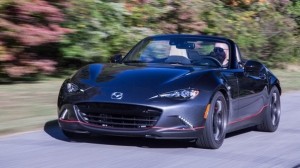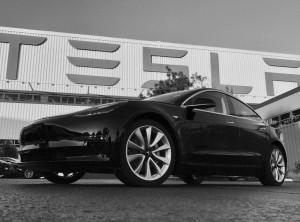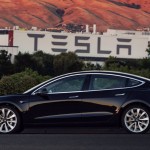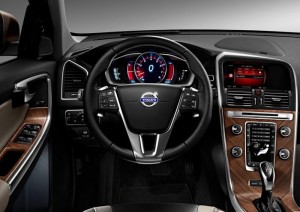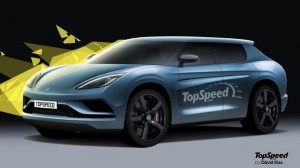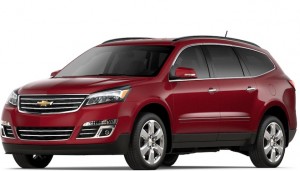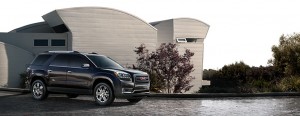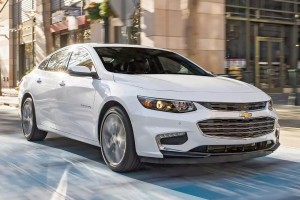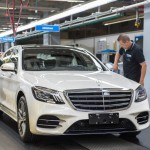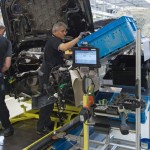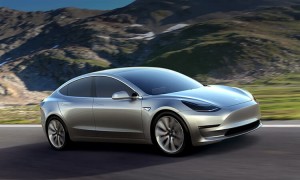Monthly Archives: July 2017
Top 3 Features of the Long Road Racing “Ultimate MX-5”
Long Road Racing, which has been reputed for its amazing work on some tuner packs, released one for 2017 Mazda MX-5 called the Ultimate MX-5. If you have a 2016 or 2017 MX-5, but felt that it has not lived up to expectations, you may want to look at what Long Road Racing is offering.
1. Exterior
According to TopSpeed, LRR did not give much focus on upgrading the exterior details of the MX-5, though it offers a lot of wheel and tire combinations. In particular, it’s suggesting customers to get the 17-inch Ray’s forged wheels which are wrapped in BFGoodrich g-Force Sport COMP-2 Ultra high-performance tires.
MX-5 owners would be hard-pressed to look for tuners that offer exterior upgrades for the sports car. The MX-5 already looks good enough as an entry-level performance car, and tuners should focus on giving it more power than upgrading its aesthetics.
2. Interior
LRR’s focus is to make the MX-5 feel more like a race car in the interior. This means stripping it off of all the comforts associated with a luxurious car, and fitting it with race-spec elements, safety equipment, and all-around weight shedding. Some of the race car-spec elements are a roll cage with NASCAR-style bars on both sides of the car, a centralized command center (which means removing the AC system) for power, fire bottle, and pump overrides.
There would also be head net constraints, Lifeline Zero 2000 fire system, seat mounting plates, foot well floor panel, a dead pedal, and a steering wheel with no air bags.
3. Drivetrain
This is where LRR truly went all out. The MX-5 is fitted with a 2.0-liter 4-cylinder engine, and LRR wants to boost its 155-horsepower output through a Setrab engine oil cooler, a race-proven water radiator, gold heat reflection materials, and motor-mounted positive location limiters.
Other upgrades are new limited-slip differentials, differential and transmission oil coolers, and pumps for upgrades.
Pricing
LRR did not release a price tag for the tuning package because it would depend on what the clients want done on their MX-5. Customers can customize their package based on their desired enhancements.
Tesla Rolls Off First Model 3 As Mass Production Begins
Tesla CEO Elon Musk has given car enthusiasts and experts a glimpse of the very first production version of the Model 3, the company’s third production vehicle following Model S and Model X. Musk did well on his promise to start off mass production before the week ends as he tweeted earlier that Tesla plans to roll off 20,000 units by December 2017.
The Model 3 sits below the larger Model S, and is even more affordable with a suggested retail price of $35,000, excluding government incentives. The release of the Model 3 on Friday launched Tesla to a bigger market, where people are more interested to investing in electric cars, particularly the Tesla brand.
According to a tweet from Musk, the first Model 3, which he named SN1 (Serial Number 1), is completed and is on its way to the inspection board. “Production unit 1 of Model 3 is now built and going through final checkout. Pics soon.”
The first Model 3 was supposed to be reserved for Tesla board member Ira Ehrenpreis, who was the first to place a full deposit for the model. But instead of taking the car for himself, Ehrenpreis gave the first-slot rights to Musk as a 46th birthday gift.
Ehrenpreis will instead have the rights to the second production car, the Tesla CEO said in a tweet. Musk did not reveal any updates about the Model 3’s powertrain, but there should be more details in the coming weeks.
Customers to Get Their Hands on Model 3 by July 28
There is a huge demand for Model 3 and hundreds of thousands of people have already reserved for a unit, which will begin deliveries on July 28. By December 2017, Tesla plans to produce 20,000 units and 500,000 vehicles annually by next year.
Musk is confident that demand for the Model 3 will increase “exponentially” in the coming months.
Tesla Model 3 Photos
Here is a glimpse of the Tesla Model 3:
Is There A Ferrari SUV In The Works?
For many years now, car enthusiasts and experts have been wondering whether there will be a day that a Ferrari SUV will come zooming beside them on a stoplight. That would give commoners plenty of reasons and time to ogle at probably the most expensive SUV in the market.
In a report by CarAndDriver, Ferrari CEO and Fiat Chrysler Automobiles head Sergio Marchionne said, “You have to shoot me first” before we’ll ever get to see a Ferrari SUV. That seems to change now because more and more high-end auto brands are being seduced by the big chunk of market ready to spend money on an SUV.
High-end brands such as Porsche, Bentley, Aston Martin, Jaguar, Lamborghini, Maserati, and Rolls Royce are diving into the pool of luxurious SUV production because of the fat profits gained from selling the auto. Now, there are also reports that Ferrari is readying its version of SUV (codename Project F16X).
The public will likely see the arrival of the Ferrari SUV in 2020, along with the follow-up to the GTC4Lusso. Right now, the Lusso is already an all-wheel drive, but thanks to the platform being developed for the F16X, it can get a higher ride height and a four-door coupe body.
The GTC4 will continue offering a V-12 engine while Ferrari’s planned SUV variant will most probably have a V-8 or hybrid powertrains.
Rise in Profit
Although Marchionne might have problems with the current Ferrari plan to have an SUV, it wouldn’t take much to convince him to try it out. The brand currently produces 8,000 to 16,000 units of Ferrari cars. Having an SUV, with that big of a market, in your lineup will significantly up the profit.
In truth, there is no indication that Ferrari would call this an SUV. It can be a crossover or Ferrari could simply create something out of thin air for the SUV.
2018 Nissan Leaf Features Self-Parking System
More than its celebrated self-driving capabilities, Nissan is also debuting its self-parking system in the 2018 Nissan Leaf and ProPilot system. Not only will the Leaf be able to make autonomous driving possible, it will also park itself with a click of a button.
The latest teasers for the next-generation 2018 Leaf showed the ProPilot Park. The driver can simply activate the system by pushing a button and searching for their ideal parking space. Once the spot has been chosen and located, the driver will hold down the park button and the 2018 Leaf would take over the handling of the steering input, braking, and light acceleration to park the car perfectly.
Nissan, of course, is still asking drivers to be mindful and attentive in monitoring their surroundings when Leaf is on the ProPilot Park system. The brand, however, is confident that the system will eliminate the stress coming from parking in tight quarters.
ProPilot Assist for Self-Driving Capabilities
Aside from the ProPilot Park system, which would be the perfect companion for those challenged by tight parking spaces, the all-new Nissan Leaf is also offering ProPilot Assist to provide self-driving capabilities in single-lane highway scenarios. So far, the system will be able to handle accelerating, braking, and steering in the proper conditions.
Nissan said the system will eventually navigate city intersections. The technology for this capability is just around the corner.
Nissan Leaf to Arrive September 6
By September 6, Nissan will unveil the 2018 Leaf. Hopefully, it will follow its predecessor’s footsteps because the current-generation Nissan Leaf is the best-selling electric car worldwide. Since its launch in 2009, it sold 260,000 units globally.
There are still no technical specifications released for the 2018 Nissan Leaf, though there will surely be a wide variety of electric ranges to be offered once it’s released. The current maximum range in the electric vehicle range is 2017 Chevrolet Bolt EV’s 250 miles, but the Leaf may exceed that.
Volvo To Offer Only Electrified Powertrains In The Future
Volvo is joining the rest of the European car manufacturers in steering the auto industry towards an electrified future. The company announced on Wednesday that it will only offer electrified powertrains starting in 2019, completing phasing out the internal combustion engine from its lineup.
According to Autonews, Volvo CEO Hakan Samuelsson said in a statement that the announcement comes on the heels of the manufacturer’s plans to sell one million electrified cars by 2025. “When we said it[,] we meant it. This is how we are going to do it.”
Back in 2014, Volvo revealed plans of offering a plug-in hybrid alternative alongside versions of its traditional gasoline and diesel-powered engines. The company CEO explained that the move will allow Volvo to “stand out” from their competitors.
Henrik Green, Volvo’s research and development head, told the source that vehicles powered only by a combustion engine would be phased out from the company’s lineup between 2023 to 2025. That’s a long way from now, but it seems to look doable under Volvo’s current plan.
Between 2019 and 2021, Volvo plans to offer five cars from its full-electric lineup. The company presently has nothing in this department, but the next years will prove challenging for the car manufacturer as it shifts away from the use of combustion engine.
Three of the planned full-electric vehicles will come from Volvo while the remaining two cars planned will be produced by Polestar, which parent company Volvo plans to transform into a stand-alone brand for high-performance electric vehicles.
Electrified Technology is on the Rise
Volvo’s electrified models will be manufactured in its factories in Europe, China, and the United States. Although heftier in investment costs, Samuelsson told Reuters this will be shouldered by the company’s existing budget.
The switch towards an electrified future is a move well-recognized in Europe, where analysts ave been predicting the rise in electronic technology by 2020. Aside from Volvo, its competitors Renault and the Volkswagen Group are also offering hybrid technology.
A number of key European cities may also be banning the use of diesel engines, but the cost of an after-treatment systems to make diesel comply to new emissions regulations may not be worth the investment.
4 Major Predictions About The 2020 Koenigsegg SUV
Swedish car manufacturer Koenigsegg has been adamant that it won’t join the current fray of SUV lineups by supercar makers such as Bentley and Lamborghini. Still, many car analysts and experts believe the company won’t be able to resist the temptation of creating something spectacular—perhaps even the most luxurious, high-performance SUV ever?
1. Exterior
The rendering featured in TopSpeed of what could possibly be the Koenigsegg SUV in the future will take its exterior cues from its current lineup of supercars, the Agera and the Regera. At the front, the headlights are going to be the same, albeit larger version, as those found on the Agera. The artist, however, believed the SUV will carry a new LED pattern at the edges.
On the sides, the SUV would most probably have the same lines as the Regera, though the rendering decided to turn these lines into a milder version since aggressive styling won’t really be what Koenigsegg would be after with its first SUV. The vision has the SUV with a sleek, low roofline with short side windows, as well as a straight roof and heavily raked C-pillars and rear windscreen.
The large wheels would have lightweight rims from the use of carbon fiber, but massive brake calipers would provide for the sporty look.
The rear, on the other hand, should have a natural flowing line highlighted by horizontally-oriented taillights and detailing that would give the SUV a wider stance.
2. Interior
The Agera and Regera are recognized by its sporty and luxurious interiors, but the SUV will most probably go for the luxury rather than a sporty appearance inside. The highlight of the SUV would be the dashboard as it has to comply to the wider center stack and the taller center console, thanks to a higher seating position.
By 2020, Koenigsegg would have a new technology to tinker with when it comes to the infotainment system. It would definitely have more features, more options, a larger display, and an instrument cluster that can display more numbers than the current performance data. Standard to the SUV’s interior appearance would be leather and Alcantara, though there is also the expectation of aluminum and carbon fiber elements.
3. Drivetrain
The question is: Will Koenigsegg go with the conventional or an all-electric setup for its drivetrain? A conventional setup means the Swedish company might use a twin-turbocharged 5-liter V-8 engine and a dual-clutch transmission that can produce around 600 to 700 horsepower.
It could also opt for a hybrid drivetrain, pairing the 5-liter V-8 engine to at least three electric motors. It could use the Koenigsegg Direct Drive, that patent-pending tech that would use an electric motor instead of the current gearbox.
4. Prices
The SUV won’t cost as much as the Agera, currently priced at $2 million, but it won’t go below $1 million either.
Top 3 Truly American Cars in 2017
How would you recognize all-American cars from the ones which were merely assembled in the US but used Japanese mechanics? The global economy opened up the possibility for car manufacturers to source their materials from all over the world. A single vehicle can be planned in Germany but assembled in Asia with parts coming from North America.
To be able to determine which are truly American cars, Frank DuBois, an associate professor at the American University Kogod School of Business, developed a formula based on the car’s final assembly point, its major components, the headquarters of the manufacturer, the research-and-development centers, and the percentage of US and Canadian parts in the vehicle.
1. Chevrolet Traverse
Seventy one percent of the Chevrolet Traverse’s parts come from the United States and its neighbor, Canada. Its manufacturer, General Motors, has headquarters in Detroit while the Traverse itself was produced and assembled in a factory in Lansing, Michigan.
The Traverse was completed redesigned for 2018. It is powered by a 281-horsepower V-6 engine with either a front- or all-four-wheel drive system. This will be paired with a six-speed automatic.
2. Buick Enclave
Like the Traverse, the big, bad Buick is made at GM’s Lansing, Michigan assembly plant. According to Prof. DuBois’ calculation, the Buick is 85.5 percent American, thanks to being part of an assembly plant that GM said produced more than two million vehicles to date.
The Buick Enclave is going to be redesigned for 2018, so expect a 288-horsepower 3.6-liter V-6 engine paired with a six-speed automatic and either a front- or all-wheel drive system. The new Enclave will be on sale starting Autumn 2017.
3. GMC Acadia Limited
The Acadia Limited is the older and longer three-row crossover that is the predecessor of the current redesigned GMC Acadia. The older one is certainly more American than the current model in the market, though the Limited is still being sold alongside it. Like the Traverse, the Acadia Limited’s parts are 71 percent from the US and Canada.
The Acadia Limited boasts of its roomy interior that is packed with cool features such as the Apple CarPlay, Android Auto, 4G LTE connectivity, and mobile Wi-Fi. There are two options available: the 2.5-liter four with 193 horsepower and the 3.6-liter V-6 with 310 horsepower.
3 of the Best Car Deals for the Fourth of July
Independence Day weekend is the best time to troop to your local car dealership and check out what “surprises” are in store for you in terms of low prices and high incentives for slow-selling car models. Manufacturers aim to boost the presence and the sales of these models by offering it for a lower price in time for the Fourth of July celebration.
If you’re eyeing a particular sedan or SUV, you may want to look at this list and hope it’s one of these slow-selling models you can get for less than its original price:
1. 2017 Chevrolet Sonic
Priced at $15,145, the 2017 Chevrolet Sonic has been refreshed for the 2017 model year. However, its sales have decreased by 44.9 percent this year compared to the same period last year. The Sonic is a good value because it handles well and is comfortable, thanks to its turbocharged engine. Inside this subcompact car, it has plenty of seating and cargo. It also has an aesthetic upgrade, including the Apple CarPlay and Android Auto compatibility.
2. 2017 Kia Sportage
At $23,200, the Kia Sportage is certainly a car you can pick up right now. You think that extensive upgrades would up the sales? That did not happen to the Sportage. Instead, sales of this compact SUV declined by 16.6 percent this year compared to the same period in 2016. Last month, Sportage sales were down 18.3 percent compared to the same month last year.
If you want this bad, you can even get this for zero percent financing for five years before July 10. The Sportage has roomy seating, composed handling, premium cabin materials, and user-friendly tech. If you want better cargo space, though, you have to check out Honda CR-V, Subaru Forester, and Toyota RAV4.
3. 2017 Chevrolet Malibu
The 2017 Chevrolet Malibu has been hailed as the Best Midsize Car For Families because of its crash test scores, seating and cargo space, and reliability rating. But all of these do not mean good sales for the Malibu because recent reports indicated that Chevy sold 30 percent less units compared to the same period last year.
Now priced at $21,680, the Malibu is an even better car to get your hands on.
New Mercedes-Benz S-Class Shows Self-Driving Feature
The production of the Mercedes-Benz S-Class commenced on July 3 at the Sindelfingen plant of the three-pointed star brand. The first S560 model produced by the facility showed its self-driving capability during the event.
The new Mercedes-Benz S-Class is a facelifted version of its range’s sixth-generation platform introduced in 2014. Among the notable visual upgrades of the car include the new bumpers, lighting system and radiator grille. At present, the vehicle is available in different trims including the S350d 4MATIC, S400 4MATIC, S560 4MATIC and the range-topping AMG S63 4MATIC. The non-AMG models come in long-wheelbase versions and the S560 is sold with a Mercedes-Maybach variant. Daimler confirmed that a plug-in hybrid version of the S-Class will also come out.
The self-driving feature of the S-Class was demonstrated by a S560 model. An obsidian black metallic-finish model aided by built-in cameras, radar and ultrasonic sensors drove itself for 1.5 kilometers from the assembly line to the loading area of the plant. A software governing the Intelligent Drive, Active Distance Assist DISTRONIC and Active Steer Assist made the feat possible.
In the video below, Markus Schafer, Member of the Divisional Board Management of Mercedes-Benz Cars Production and Supply Chain Management, can be seen sitting in the front passenger area of the S560. No one sat on the driver’s seat of the car as it accelerated and steered itself autonomously.
Click play in the video below to watch the demo of the self-driving Mercedes-Benz S560:
Mercedes started the sale of the S-Class in May. The price of the car starts at 88,446.75 euros in Germany (inclusive of 19% VAT). The high-performance Mercedes-AMG S63 4MATIC comes with a 160,293 euros price tag (including a 19% VAT).
The S350d 4MATIC is equipped with a 210 hp diesel-fed 3.0-liter inline-six engine. The S400 4MATIC is offered in petrol 3.0-liter inline-six engines configured to produce 250 hp and 340 hp. The S560 is equipped with a 4.0-liter V8 in 345 hp and 469 hp powertrain. The AMG variant is packing a 4.0-liter V8 in 450 hp and 612 hp trims.
Customers Can Get Their Hands On First Tesla Model 3 On July 28
Shortly after leaving US President Donald Trump’s advisory board, Tesla and SpaceX CEO Elon Musk went right into a lifelong work—producing environment-friendly vehicles. On Monday, he announced on Twitter that the first Tesla Model 3 would be completed this Friday, July 7.
In his first tweet, Musk said that Model 3 “passed all regulatory requirements for production two weeks ahead of schedule.” This gives the Model 3 enough time to be finished and completed this Friday.
Earlier reports said that Tesla would aim to start the production of the company’s Model 3 this July despite a first-quarter loss. It seems Tesla indeed reached its goal because in his second tweet, Musk revealed that the first 30 owners of Model 3 will have the vehicle by July 28. There was even a mention of a “handover party.”
The production for Tesla’s Model 3 will continue to grow in the coming weeks, the same tweet said. The Tesla CEO said there should be 100 cars available in August and above 1,500 units by September. In his third and final tweet, which was also the shortest in the series, Musk estimated that Tesla would be able to produce around 20,000 units a month of the Model 3 by December this year.
If the company would be able to reach that target, then they would be addressing the backlash over the production delays that plagued the previous Model X.
In another tweet, the Tesla CEO thanked everyone who “own or ordered a Tesla.” “It matters to us that you took a risk on a new car company. We won’t forget.”
Model 3 to be priced at $35,000
Tesla’s Model 3 is expected to come with a price tag of $35,000, but that’s before government incentives. It will have a driving range of more than 215 miles and will be able to reach 60 mph in 5.6 seconds.
Inside, the Model 3 will be equipped with a 15-inch center touchscreen, which is only slightly smaller than the Model S’ version. It has 14 cubic feet of volume in the front and rear cargo.

